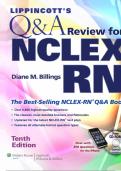Exam (elaborations)
LIPPINCOTT Q&A REVIEW FOR NCLEX-RN 10TH EDITION BY DIANE M. BILLINGS
- Course
- Institution
- Book
Practice Makes Perfect with Lippincotts Q&A Review for NCLEX-RN®! Trusted by successful nursing students, Lippincotts Q&A Review provides more practice questions than any other book, plus the essential preparation strategies you need to succeed on the NCLEX-RN examination! Written by Diane B...
[Show more]



